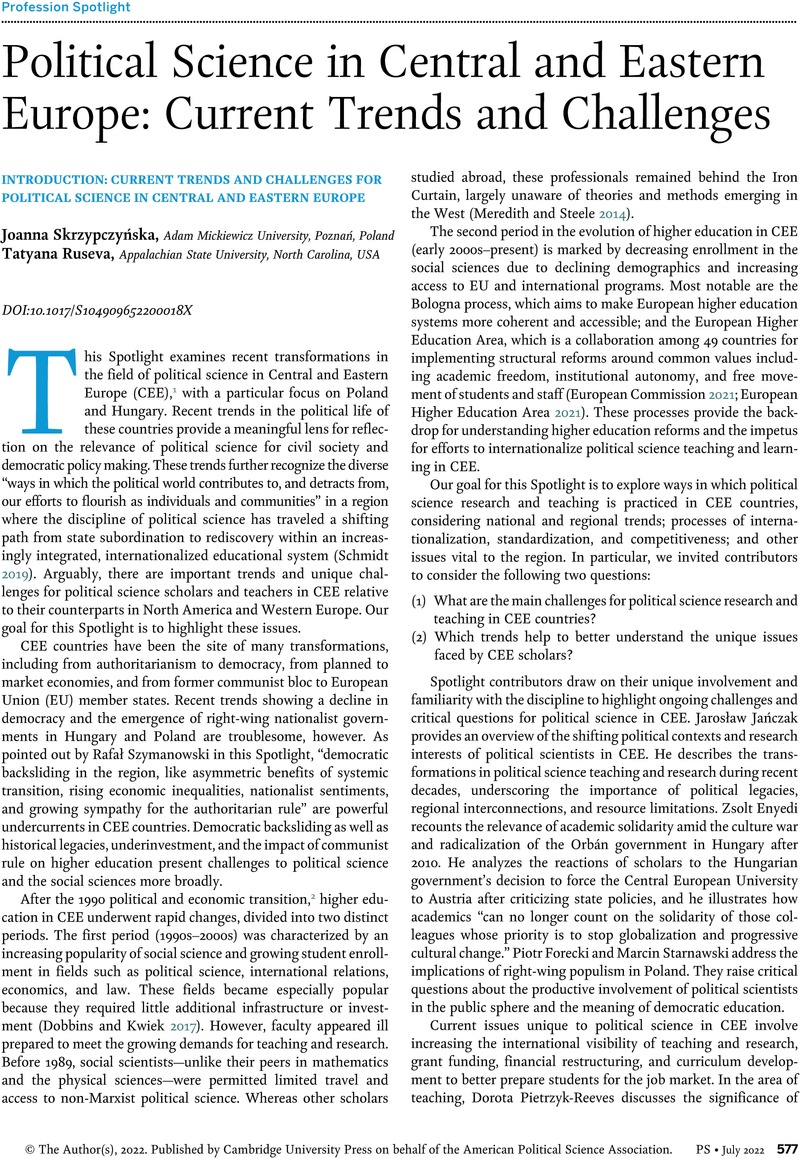No CrossRef data available.
Article contents
Introduction: Current Trends and Challenges for Political Science in Central and Eastern Europe
Published online by Cambridge University Press: 13 June 2022
Abstract
An abstract is not available for this content so a preview has been provided. Please use the Get access link above for information on how to access this content.

- Type
- Political Science in Central and Eastern Europe: Current Trends and Challenges
- Information
- Copyright
- © The Author(s), 2022. Published by Cambridge University Press on behalf of the American Political Science Association
References
REFERENCES
Dobbins, Michael, and Kwiek, Marek. 2017. “Europeanisation and Globalisation in Higher Education in Central and Eastern Europe: 25 Years of Changes Revisited (1990–2015).” European Educational Research Journal 16 (5): 519–28. DOI:10.1177/1474904117728132.CrossRefGoogle Scholar
European Commission. 2021. “The Bologna Process and the European Higher Education Area.” Brussels, Belgium: European Commission, Education and Training. https://ec.europa.eu/education/policies/higher-education/bologna-process-and-european-higher-education-area_en.Google Scholar
European Higher Education Area. 2021. “European Higher Education Area and Bologna Process.” https://ehea.info.Google Scholar
Forecki, Piotr, and Starnawski, Marcin. 2022. “Political Scientists’ Public Involvement and the Meanings of Democratic Education: Critical Questions from Poland.” PS: Political Science & Politics. DOI:10.1017/S1049096522000117.Google Scholar
Meredith, Kurtis S., and Steele, Jeanine L.. 2014. “Education in Transition: Trends in Central and Eastern Europe.” In Handbook of Reading Research, ed. Kamil, Micheal L., Mosenthal, Peter B., and Barr, Rebecca, 29–39. New York: Routledge Handbooks Online. DOI:10.4324/9781410605023.Google Scholar
Organisation for Economic Co-operation and Development. 2001. “Central and Eastern European Countries (CEECS).” Glossary of Statistical Terms. https://stats.oecd.org/glossary/detail.asp?ID=303.Google Scholar
Roaf, James, Atoyan, Ruben, Joshi, Bikas, Krogulski, Krzysztof, and an IMF Staff Team. 2014. “25 Years of Transition Post-Communist Europe and the IMF: Regional Economic Issues Special Report.” 1–72. Washington, DC: International Monetary Fund. www.imf.org/~/media/websites/IMF/imported-flagship-issues/external/pubs/ft/reo/2014/eur/eng/pdf/erei_sr_102414.ashx.Google Scholar
Schmidt, Ronald. 2019. “Reflections of a Political Scientist.” PS: Political Science & Politics 52 (1): 69–70. DOI:10.1017/S1049096518001300.Google Scholar




